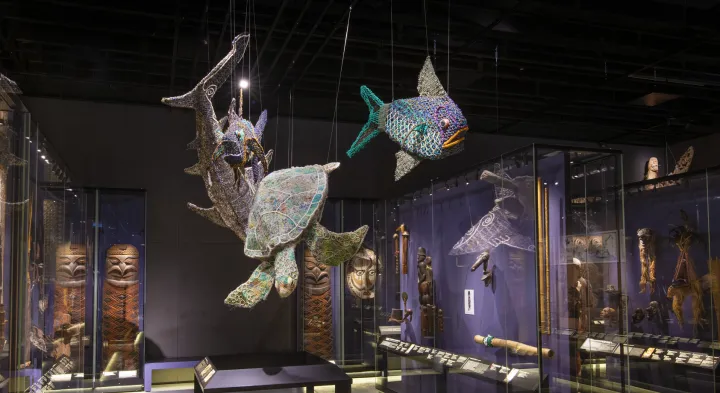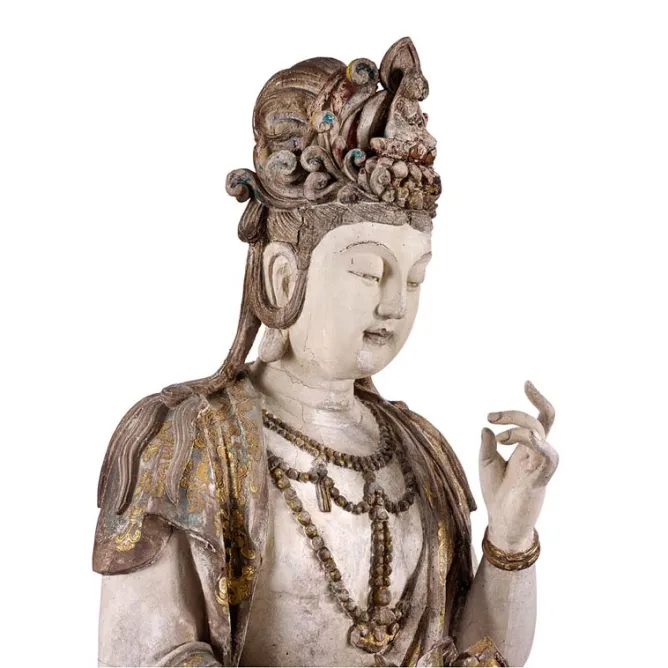Permanent exhibition
The Archives of Human Diversity
In 2024, the permanent exhibition will close temporarily between 5 August and 31 October 2024. The revamped exhibition route will be inaugurated on 1 November. Guided tours and workshops resume on Tuesday 5 November 2024.
More than 1,000 objects, admirable messengers of the world's cultures, have been carefully selected from the 74,000 that make up the MEG collections to be included in the permanent exhibition.
Download the audio guide for free
on AppStoreor Google play.
e-MEG is the digital double of the permanent exhibition. It includes an audio guide and full descriptions and photographs of the objects on display.
The memorial nature of the heritage gathered in this permanent exhibition - complemented by digital information from the eMEG - will speak to every visitor, wherever they come from, reviving a sense of belonging to a territory and an identity. Visitors will be able to come back as long as they wish to immerse themselves in one or other of the world's cultures, not least because admission to the exhibition is free of charge.
Practical informations
2nd basement
Tuesday to Sunday
from 11:00 to 18:00
Accessible to persons with reduced mobility
The permanent exhibition is free of charges.
Scenographed by the Atelier Brückner in Stuttgart, the exhibition is divided into seven chapters: a historical prologue, followed by a presentation of the collections from the five continents and the ethnomusicological collection.

Sea, 2014
Video installation by the artist Ange Leccia
Vidéo HD. Acquired by MEG in 2014
MEG Inv. ETHEU 800004
Prologue
Upon arrival, the public is immersed in the origins of Geneva's ethnographic collections. One learns, not without exaltation, that they are the fruit of individual adventures, of the passion and generosity of illustrious characters and others more modest, of encounters with cultures near and far.
Five continents
Each section has its strong points, its masterpieces, which have enabled us to identify themes specific to each one. Thus the section devoted to Asia takes us from the Bosphorus to an ever more distant East by tackling three major themes: religious iconography, writing and power.
The pictorial art draws a guiding thread along the African route, which is divided into cultural areas. Within these, themes such as the sacred, linked to the cult of ancestors and magical-religious practices, and power emerge.
Within these, themes such as the sacred, linked to ancestor worship and magical-religious practices, and power emerge.
The section dedicated to Oceania, a vast "island continent" of more than ten thousand islands, deals with the relationships and exchanges of Indigenous societies and the journeys of the Europeans who explored this region of the world.
From the Arctic Circle to Tierra del Fuego, the Americas collection is among the most culturally and chronologically diverse, covering nearly 9,000 years of history. Paying tribute to this wealth, the American journey ranges from the Inuit art of the Far North to South America, through the Amerindian societies of the North American plains and pre-Columbian cultures.
Few ethnographic museums have objects from the European continent in their collections, so much so that exoticism seems to prevail elsewhere. This is not the case, however, with the MEG, whose vocation is the conservation and study of material, cultural and artistic testimonies from all over the world, including Europe. Around everyday objects from rural and alpine society or from the urban world of workers and scholars, universal questions such as life, death, religious or political practices resonate, touching and challenging each and everyone.
Ethnomusicology
Ethnomusicology is not to be outdone, since a section is devoted to it. In this section, two complementary groups interact and respond to each other: the collection of instruments from all over the world and the International Archives of Popular Music (IAPM).
They highlight organological classification (instrument studies) - a field of research in which the MEG has made a major contribution to the development - and field research, from sound recording to the constitution of musical instrument ensembles.




